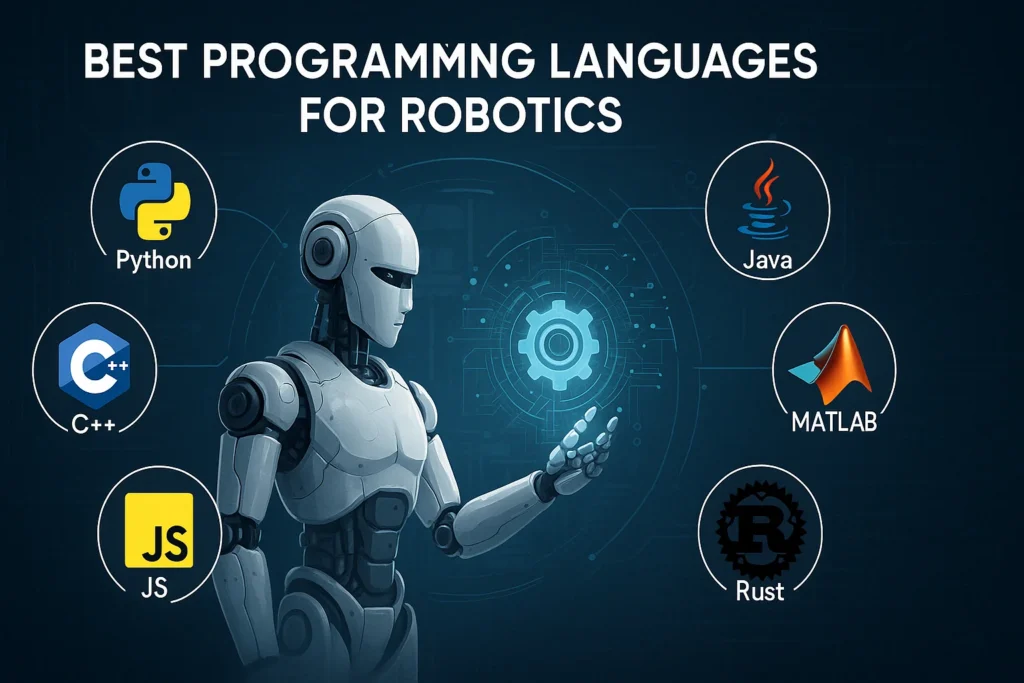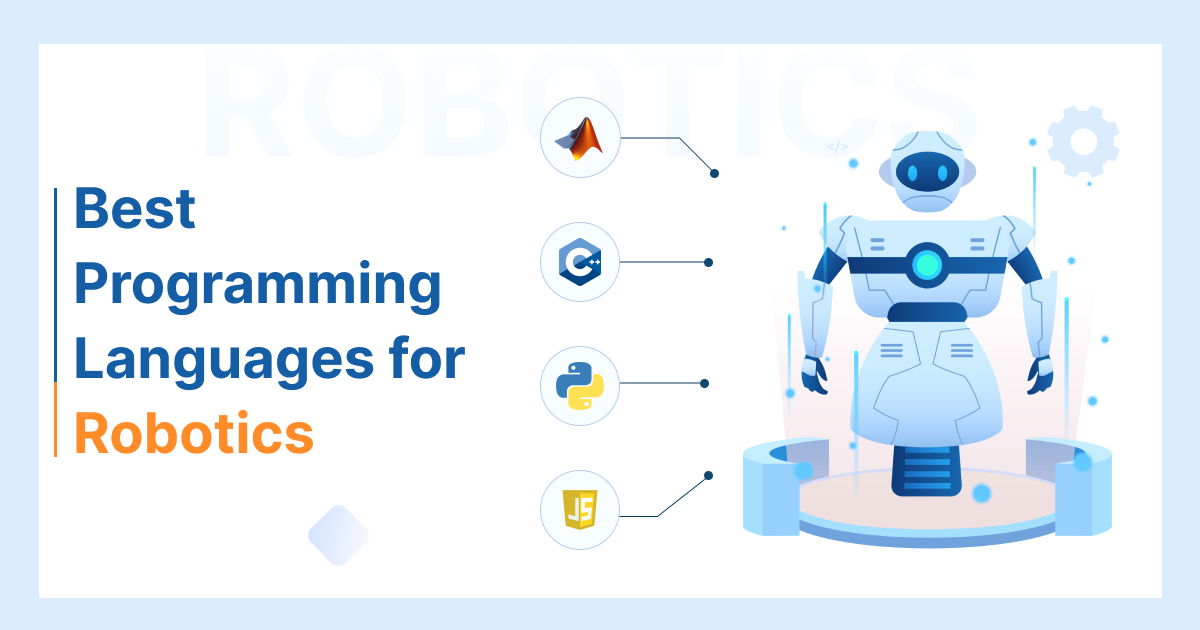Choosing the best programming language for robotics isn’t just about speed or syntax. It affects how your robot performs in real-time, how quickly you can scale, and how easily you can find the right developers. Get it wrong, and you risk delays, rewrites, or worse, an unusable product.
From Python and C++ to Rust, Java, MATLAB, and JavaScript, the options can feel endless. Each has strengths, tradeoffs, and specific use cases. The challenge is determining which programming languages for robotics are most suitable based on your project goals, hardware setup, and available talent.
In this guide, we’ll break down the most used and best programming languages for robotics in 2025, explain when to use each, and help you match your tech stack to your product and your people.
What to Consider When Choosing a Robotics Programming Language
Choosing the right programming language isn’t just a technical decision. It’s a strategic one. The language you pick shapes how fast you can build, how easy it is to scale, and how costly it’ll be to maintain.
Here are five core factors to weigh before locking in your tech stack:
1. Type of robotics application
Your programming language should match the capabilities of your robot. AI-driven systems, such as autonomous vehicles and service bots, often rely on Python for its flexibility and strong machine learning support.
For real-time control, such as in drones or industrial robots, C or C++ is a better fit due to their speed and low-level hardware access. In hybrid systems or simulations, teams usually combine languages—Python for AI, C++ for control, and MATLAB for advanced modeling. Choosing the right mix keeps your robot efficient and facilitates easier scaling.
2. Hardware requirements and compatibility
Not all programming languages are compatible with all hardware. Microcontrollers with limited memory or processing power often require efficient programming languages like C or C++.
If you’re using frameworks like ROS, your choices shrink further because Python and C++ are the standard and widely supported in the ecosystem. Choosing a language that initially fits your hardware and toolchain helps you avoid integration issues and unnecessary rework.
3. Real-time performance vs. development speed
Every language comes with tradeoffs. C and C++ offer the speed you need for real-time robotics, but take more time to build and debug. Python is faster to develop with and works well for AI and research, though it runs slower than compiled languages.
Languages like Rust are gaining traction as a middle ground for teams that want modern features without sacrificing speed. It delivers near-C++ performance with safer memory handling, but experienced developers can be harder to find.
4. Talent availability and cost
The best language won’t matter if you can’t find people who can use it. Python and JavaScript are easier to hire for, while C++ and Rust require more specialized (and often pricier) talent.
If you’re outsourcing or working with external teams, choose a language that has a strong and accessible talent pool. It’ll save you time, budget, and stress down the line.
If you’re unsure where to start, check out our guide to hiring robotics developers for tips on sourcing and vetting technical talent for specialized projects.
5. Integration with existing systems or cloud services
Robots rarely operate in isolation. Most real-world projects must integrate with other systems, such as cloud dashboards, mobile apps, APIs, data pipelines, or IoT networks.
Languages like JavaScript, Java, and Python facilitate integrations, especially when building companion tools or synchronizing data in real-time. Choosing a language that aligns with your broader tech stack, from deployment to maintenance, keeps everything running smoothly.
Robot Operating System (ROS): The Framework That Ties It Together
Most robotics projects today don’t start from scratch. They begin with ROS. Whether building an autonomous delivery bot or managing a drone swarm, ROS often acts as the glue that keeps your hardware and software in sync.
ROS isn’t an operating system. It’s a middleware framework that helps robotics components communicate through a publish-subscribe model, utilizing services and tools such as roslaunch and rosbag. It allows your team to focus on the logic that drives the robot, rather than rebuilding the basics.
Python and C++ are the main languages used with ROS. Most packages are built with them. Python is well-suited for simulations and high-level logic, while C++ provides more control over memory, timing, and hardware. Sticking to either one keeps integration smoother and support easier.
ROS 1 is still the most commonly used version, but doesn’t natively support real-time execution. That’s a problem for safety-critical systems, such as surgical robots or autonomous vehicles, where timing is crucial.
ROS 2 enhances real-time support, security, and multi-robot handling, but it’s not a plug-and-play solution. Developers must configure DDS middleware, manage node lifecycles, and tune QoS settings. Companies like Clearpath and Foxglove are already using ROS 2 in production, demonstrating its growing maturity and momentum.
One of ROS’s advantages is that it breaks down your system into independent nodes, each handling a specific task, such as camera input, path planning, or obstacle detection. This modular setup facilitates easier testing, scaling, and assigning work across teams. For example, a team building a warehouse automation robot used separate ROS nodes for lidar mapping, wheel control, and route optimization. That structure made it easier to isolate bugs, test modules in parallel, and scale the system faster.
The downside? ROS isn’t beginner-friendly. Teams without prior experience often spend weeks just getting the architecture stable. If ROS is central to your project, collaborating with engineers who have shipped with it can save you time, reduce rework, and mitigate the risk of system failures later.
Best Programming Languages for Robotics

Choosing a language for the best results in robotics development isn’t just about popularity but precision. Each language has its strengths, ranging from real-time performance to AI integration and cloud connectivity, depending on your system’s specific needs. Now, let’s break down the best coding languages for robotics and where each fits in a modern tech stack.
1. Python
Python is one of the best programming languages for robotics, particularly when development speed is a key consideration. Its simplicity, extensive libraries, and strong AI and machine learning performance make it a go-to for high-level robotics tasks.
Teams building autonomous delivery bots use it for navigation, computer vision, and simulations before testing on real hardware. It’s not the fastest at runtime, but when you need to move quickly and iterate often, Python is hard to beat.
2. C++
C++ is one of the most used programming languages for robotics, especially at the hardware level. It provides low-level access, precise control over system resources, and the speed required for real-time decisions. It’s commonly used in robotic arms, drones, and embedded systems where timing is critical.
Johnson & Johnson MedTech utilized C++ to develop a distributed surgical robot that meets stringent medical standards and delivers safety-critical performance, which higher-level languages like Python cannot reliably support.
3. Java
Java is not always at the forefront of robotics, but it plays a significant role in systems that require platform independence and robust backend integration. It is often used in educational robotics platforms, Android-based robots, and mobile interfaces to communicate with physical robots.
4. MATLAB
MATLAB is widely used in robotics research and academic settings due to its powerful simulation capabilities, control system modeling, and matrix operations. It is not always used in production environments but is often the first stop for early-stage R&D. It is one of the best programming environments for robotics teams exploring concepts before translating them into production-ready code.
5. Rust
Rust is a relatively new addition to robotics programming, but it’s gaining traction quickly with teams developing safety-critical systems. Its memory safety, concurrency model, and predictable performance make it a strong alternative to C++.
Sonair, a robotics company specializing in 3D ultrasonic sensors, selected Rust for its embedded systems to prevent crashes and safeguard memory. It’s a solid choice when long-term stability and safety are most important.
6. JavaScript
JavaScript is not used to control robots directly, but it plays a significant role in many robotics projects, particularly those with cloud- or web-based interfaces. Developers often use JavaScript to build control panels, live dashboards, and monitoring tools that display real-time data from robots in the field.
Final Thoughts: How to Choose Based on Your Project’s Needs
There’s no perfect programming language for robotics: just the one that fits your project, performance needs, and team capabilities. Whether you’re building real-time control systems or AI-driven bots, the right language choice sets the pace for everything that follows.
Python and C++ remain the most common starting points, but the rest of your stack should reflect your goals, constraints, and who’s doing the work. Your stack isn’t just a technical decision. It’s a hiring decision, a timeline decision, and a scale decision. Choose as if your roadmap depends on it, because it does.
If you’re building a robotics product and need developers fluent in any programming language, Digitalogy can help you move faster with vetted, production-ready talent.
FAQs
Depending on their function, robots commonly use Python, C++, and Java. Python is great for AI, while C++ is for real-time tasks and embedded systems.
The most used programming languages for robotics are Python and C++, followed by Java and MATLAB. Python is popular for its ease of use, while C++ offers low-level control and performance.
Start with Python. It’s beginner-friendly and well-supported in the field of robotics. Once you’re ready, add C++ for more advanced opportunities.
Yes. Robotics relies on coding to control hardware, process sensor data, and make decisions. A solid programming foundation is essential.
Author’s Bio – Cynthia Odenu-Odenu is a B2B content writer. She helps businesses create clear, helpful content that connects with their audience. When she’s not writing for clients, she’s neck deep in a book, working on her next novel, or testing a new app for fun.







